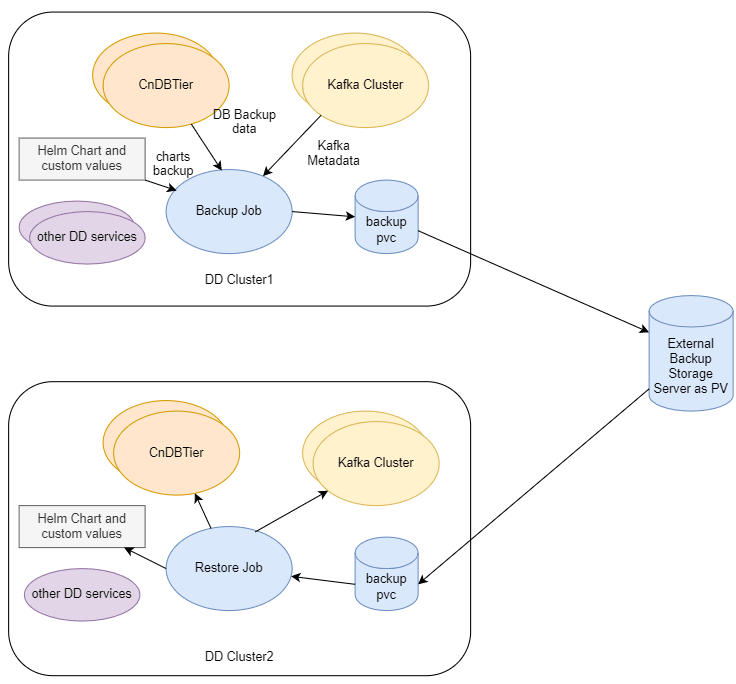7.1 Overview
This section describes procedures to perform the backup and restore for the Oracle Communications Network Analytics Data Director (OCNADD) deployment. The backup and restore procedures will be used in the fault recovery of the OCNADD. The OCNADD operators can take only the OCNADD instance specific database and required OCNADD Kafka metadata backup and restore them either on the same or a different Kubernetes cluster.
The backup and restore procedures are helpful in the following scenarios:
- OCNADD fault recovery
- OCNADD cluster migration
- OCNADD setup replication from production to development or staging
- OCNADD cluster upgrade to new CNE version or K8s version
The OCNADD backup contains the following data:
- OCNADD database(s) backup
- OCNADD Kafka metadata backup including the topics and partitions information
Note:
If the deployed helm charts and the customizedocnadd-custom-values.yaml for the current deployment is
stored in the customer helm or artifact repository, then the helm chart and
ocnadd-custom-values.yaml backup is not required.
Figure 7-1 OCNADD Backup and Restore

OCNADD Database(s) Backup
- Configuration data: This data is exclusive for the given OCNADD instance. Therefore, an exclusive logical database is created and used by an OCNADD instance to store its configuration data and operator driven configuration. Operators can configure the OCNADD instance specific configurations using the Configuration UI service through the Cloud Native Configuration Console.
- Alarm configuration data: This data is also exclusive to the given OCNADD instance. Therefore, an exclusive logical database is created and used by an OCNADD Alarm service instance to store its alarm configuration and alarms.
- Health monitoring data: This data is also exclusive to the given OCNADD instance. Therefore, an exclusive logical database is created and used by an OCNADD Health monitoring service instance to store the health profile of various other services.
The database backup job uses the mysqldump utility.
The Scheduled regular backups helps in:
- Restoring the stable version of the data directory databases
- Minimize significant loss of data due to upgrade or rollback failure
- Minimize loss of data due to system failure
- Minimize loss of data due to data corruption or deletion due to external input
- Migration of the database information from one site to another site
OCNADD Kafka Metadata Backup
The OCNADD Kafka metadata backup contains the following information:
- Created topics information
- Created partitions per topic information
7.1.1 Fault Recovery Impact Areas
The following table shares information about impact of OCNADD fault recovery scenarios:
Table 7-1 OCNADD Fault Recovery Scenarios Impact Information
| Scenario | Requires Fault Recovery or Reinstallation of CNE? | Requires Fault Recovery or Reinstallation of cnDBTier? | Requires Fault Recovery or Reinstallation of Data Director? |
|---|---|---|---|
| Scenario 1: Deployment Failure Recovering OCNADD when its deployment is corrupted |
No | No | Yes |
| Scenario 2: cnDBTier Corruption | No | Yes | No
However, it requires to restore the databases from backup and Helm upgrade of the same OCNADD version to update the OCNADD configuration. For example, change in cnDBTier service information, such as cnDB endpoints, DB credentials, and so on. |
| Scenario 3: Database Corruption Recovering from corrupted OCNADD configuration database |
No | No | No
However, it requires to restore the databases from old backup. |
| Scenario 4: Site Failure Complete site failure due to infrastructure failure, for example, hardware, CNE, and so on. |
Yes | Yes | Yes |
| Scenario 5: Backup Restore in a Different Cluster Obtaining the OCNADD backup from one deployment site and restore it to another site |
No | No | No
However, it requires to restore the database. |
7.1.2 Prerequisites
Before you run any fault recovery procedure, ensure that the following prerequisites are met:
- cnDBTier must be in a healthy state and available on a new or newly installed site where the restore needs to be performed
- Automatic backup should be enabled for OCNADD.
- Docker images used during the last installation or upgrade must be retained in the external data storage or repository
- The
ocnadd-custom-values.yamlused at the time of OCNADD deployment must be retained. If theocnadd-custom-values.yamlfile is not retained, it is required to be recreated manually. This task increases the overall fault recovery time.
Important:
Do not change DB Secret or CnDBTier MySQL FQDN or IP or PORT configurations during backup and restore.